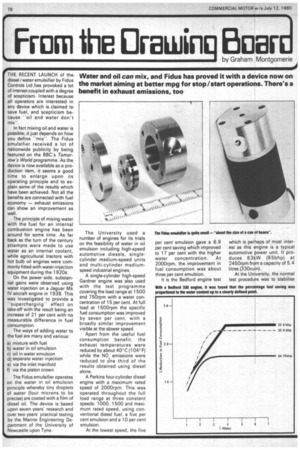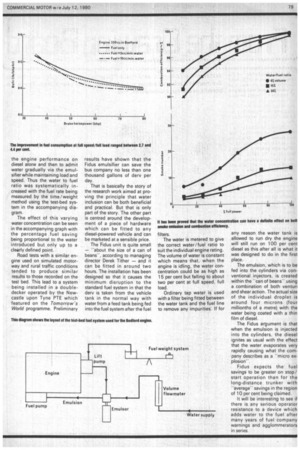From the Drawing Boar
Page 80

Page 81

If you've noticed an error in this article please click here to report it so we can fix it.
by Graham 1Montgomerie
THE RECENT LAUNCH of the diesel /water emulsifier by Fidus Controls Lid has provoked a lot of interest coupled with a degree of scepticism. Interest because all operators are interested in any device which is claimed to save fuel, and scepticism because "oil and water don't mix".
In fact mixing oil and water is possible; it just depends on how you define "mix". The Fidus emulsifier received a lot of nationwide publicity by being featured on the BBC's Tomorrow's World programme. As the device is now available as a production item, it seems a good time to enlarge upon its operating principle arid to explain some of the results which have been achieved. Not all the benefits are connected with fuel economy — exhaust emissions can show an improvement as well.
The principle of mixing water with the fuel for an internal combustion engine has been around for some time. As far back as the turn of the century attempts were made to use water as an internal coolant, while agricultural tractors with hot bulb oil engines were commonly fitted with water-injection equipment during the 1920s, On the power side, substantial gains were observed using water injection on a Jaguar Mk IV aircraft engine in 1938. This was investigated to provide a "supercharging" effect on take-off with the result being an increase of 21 per cent with no measurable difference in fuel consumption.
The ways of adding water to the fuel are many and various: a) mixture with fuel b) water in oil emulsion c) oil in water emulsion d) separate water injection e) via the inlet manifold f) via the piston crown The Fidus emulsifier operates on the water in oil emulsion principle whereby tiny droplets of water (four microns to be precise) are coated with a film of diesel oil. The device is based upon seven years research and over two years' practical testing by the Marine Engineering Department of the University of Newcastle upon Tyne. The University used a number of engines for its trials on the feasibility of water in oil emulsion including high-speed automotive diesels, singlecylinder medium-speed units and multi-cylinder mediumspeed industrial engines.
A single-cylinder high-speed Gardner engine was also used with the test programme covering the load range at 1500 and 750rpm with a water concentration of 15 per cent. At full load at 1500rpm the specific fuel consumption was improved by seven per cent, with a broadly similar improvement visible at the slower speed.
Apart from the useful fuel consumption benefit, the exhaust temperatures were reduced by about 40°C (104'F) while the NO emissions were reduced to cine third of the results obtained using diesel alone.
A Perkins four-cylinder diesel engine with a maximum rated speed of 2000rpm. This was operated throughout the full load range at three constant speeds 1000, 1500 and maximum rated speed, using conventional diesel fuel, a five per cent emulsion and a 10 per cent emulsion.
At the lowest speed, the five
per cent emulsion gave a 6.9 per cent saving which improved to 17 per cent with the higher water concentration. At 2000rprn, the improvement in fuel consumption was about three per cent emulsion.
It is the Bedford engine test which is perhaps of most interest as this engine is a typical automotive power unit. It produces 63kW (85bhp) at 2450rpm from a capacity of 5.4 litres (330cuin).
At the University, the normal test procedure was to stabilise the engine performance on diesel alone and then to admit water gradually via the emulsifier while maintaining load and speed. Thus the water to fuel ratio was systematically increased with the fuel rate being measured by the time/weight method using the test-bed system in the accompanying diagram.
The effect of this varying water concentration can be seen in the accompanying graph with the percentage fuel saving being proportional to the water introduced but only up to a clearly defined point.
Road tests with a similar engine used on simulated motorway and rural traffic conditions tended to produce similar results to those recorded on the test bed. This lead to a system being installed in a doubledecker operated by the Newcastle upon Tyne PTE which featured on the Tomorrow's World programme. Preliminary results have shown that the Fidus emulsifier can save the bus company no less than one thousand gallons of dery per day.
That is basically the story of the research work aimed at proving the principle that water inclusion can be both beneficial and practical. But that is only part of the story. The other part is centred around the development of a piece of hardware which can be fitted to any diesel-powered vehicle and can be marketed at a sensible price.
The Fidus unit is quite small — "'about the size of a can of beans-, according to managing director Derek Tither — and it can be fitted in around two hours. The installation has been designed so that it causes the minimum disruption to the standard fuel system in that the dery is taken from the vehicle tank in the normal way with water from a feed tank being fed into the fuel system after the fuel
filters.
The water is metered to give the correct water/fuel ratio to suit the individual engine rating. The volume of water is constant which means that, when the engine is idling, the water concentration could be as high as 15 per cent but falling to about two per cent at full speed, full load.
Ordinary tap water is used with a filter being fitted between the water tank and the fuel line to remove any impurities. If for any reason the water tank is allowed to run dry the engine will still run on 100 per cent diesel as this after all is what it was designed to do in the first place.
The emulsion, which is to be fed into the cylinders via conventional injectors, is created within the -can of beansusing a combination of both venturi and shear action. The actual size of the individual droplet is around four microns (four millionths of a metre) with the water being coated with a thin film of diesel.
The Fidus argument is that when the emulsion is injected into the cylinders, the diesel ignites as usual with the effect that the water evaporates very rapidly causing what the company describes as a "micro explosion-.
Fidus expects the fuel savings to be greater on stop/ start operation than for the long-distance trunker with -averagesavings in the region of 10 per cent being claimed.
It will be interesting to see if there is any serious operator resistance to a device which adds water to the fuel after many years of fuel company warnings and agglornmerators 10 series.












































































































































